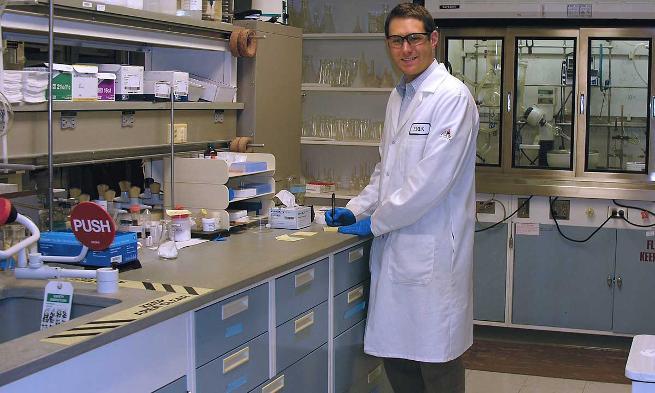JMU chemistry lab to Bristol-Myers Squibb
Health and Behavior
By Kelley Freund ('07)
It's estimated that more than 1,500 Americans will die of cancer today. And more than 1,500 will die tomorrow. And the next day. When 2012 is over, it is estimated that 577,190 people will have been beaten by cancer.
JMU alumnus Erik Stang is working to change these dire statistics. The 2006 JMU chemistry major is a medicinal chemist in the oncology discovery group at Bristol-Myers Squibb, a biopharmaceutical company that develops medicine to help patients overcome serious diseases. In 1999 President Bill Clinton awarded Bristol-Myers Squibb the National Medal of Technology, the nation's highest recognition for technological achievement, for "extending and enhancing human life through innovative pharmaceutical research and development."
Saving lives is not an easy task. But if anyone is up for the challenge, it's Stang. Former JMU professor (now assistant professor of chemistry at Villanova) Kevin Minbiole worked with Stang in his JMU organic chemistry classes. "He was tenacious in a tough project—one that would've sent a less-tough student running away," recalls Minbiole. "When things got stuck he was highly creative as he stretched his knowledge toward a solution."
Stang is using that creativity as a bench chemist at Bristol-Myers Squibb. "The purpose of my position is to synthesize drugs that will be used to treat human cancer. I really enjoy synthetic organic chemistry. My position allows me to build compounds and at the same time provides me an opportunity to make a huge impact on human health."
Stang produces compounds to be tested against cancer. Once the biology group tests the compounds, Stang looks over the data to see which compounds performed well and which ones did not. Then, using these trends, he synthesizes new compounds with refined chemical structures in hopes of improving their performance as anti-cancer drugs.
"The job is really, really challenging," says Stang. "I not only need to be an expert in synthetic organic chemistry to make these drugs, but I also need to understand the biological processes involved, so I can make better compounds. This interplay between the two fields of chemistry and biology makes my job very difficult, but ultimately very rewarding when problems are solved."
Bristol-Myers Squibb offered Stang a position while he was in graduate school earning a Ph.D. at the University of Illinois Urbana-Champaign. Typically, chemists earn their Ph.D., do a post-doc fellowship or research assignment for one or two years and then apply for jobs when they have mastered the necessary lab skills needed for pharmaceutical chemistry. "Employers also value creative employees who are good problem solvers, and I was able to demonstrate that in my Ph.D. work," Stang says.
His Ph.D. work involved making new discoveries. Stang and UIUC professor Christina White were featured in Chemical and Engineering News for their work with the Diels-Alder reaction. The Diels-Alder reaction was first documented in 1928 and won the Nobel Prize for chemistry in 1950. It is a very common organic chemical reaction, however, the dienes (hydrocarbons that contain two double carbon bonds needed to begin the reaction) are often difficult to create and are not stable. What Stang and White did is find an effective way of making the dienes in the reaction, so they are immediately ready for use. The discovery has profound implications—it saves steps and increases efficiency. Because the reaction is so useful in making pharmaceuticals, companies can use Stang and White's method to save time and money.
Stang describes his career success as a ladder of progression, which started in a research lab of JMU's chemistry department. "Undergraduate research is the hallmark of JMU's chemistry department," says Barbara Reisner, who worked with Stang in her inorganic chemistry classes. "Students have the opportunity to think of problems outside the classroom that require creative thinking and synthesizing different ideas."
"Students are not working on 'cookbooks' when they're in the lab," says Kevin Caran, JMU chemistry professor. "They're not doing things for which they know the outcome. They're doing cutting-edge research, things that are topics of interest outside of JMU."
Stang believes JMU is the perfect size school to complete a chemistry degree, large enough to offer modern labs and equipment, but small enough that students are guaranteed the opportunity to do research. "At a bigger university, it's difficult to get into a research lab as an undergrad. If you have 30,000 undergraduates and you're a chemistry major, you might not be able to join a lab."
Students not only get more opportunities to do research, but more chances to present that research at events like JMU's Spring Undergraduate Research Symposium. "Practicing scientific communication allows students to take ownership of their projects and be chemists, not just chem students," says Reisner.
Because of the upper-level courses and research opportunities in JMU's chemistry department, Stang hit the ground running when he entered graduate school and was able to launch himself into a position at an award-winning company. "I am in a fortunate position where my job is to perform cutting-edge research with the ultimate goal of curing cancer. What I love about my work is that a good day for me could change the future of health care."
Learn more about the JMU chemistry students and faculty on the JMU chemistry department website.
